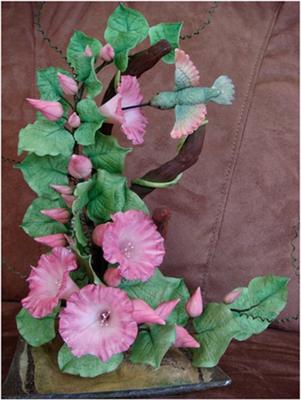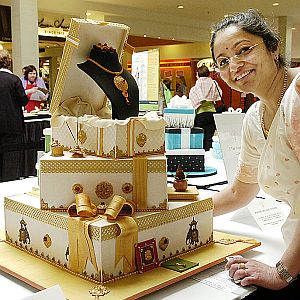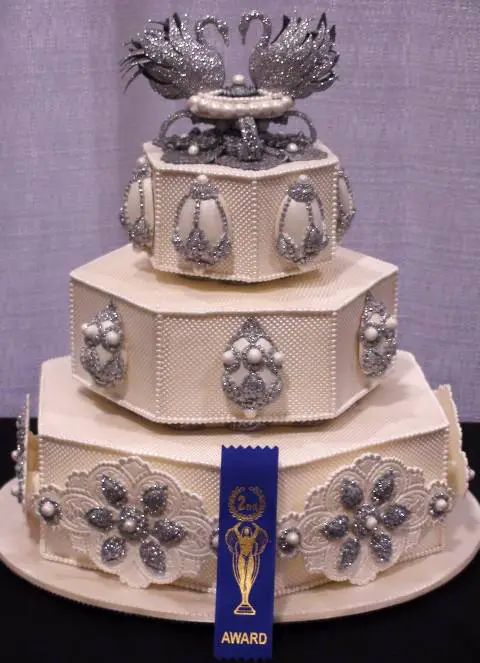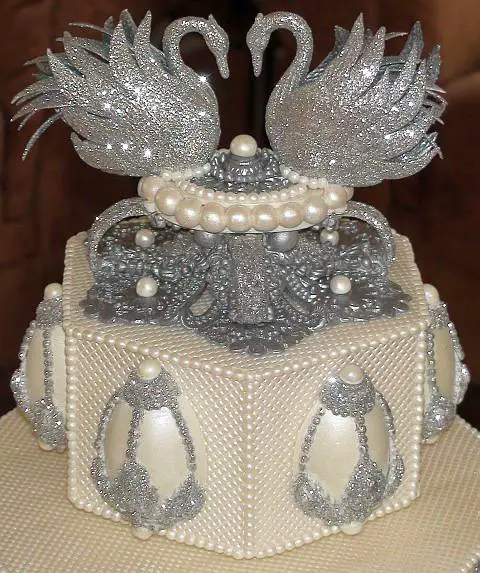Cold Porcelain Recipe
by Sangeeta
(USA)

The Humming Bird By Sangeeta Shah
(editor's note:- This is a very helpful article followed by a freely available recipe by cold porcelain expert, teacher, exhibitor and artist Sangeeta Shah. You can see more of Sangeeta's work and get her contact details on her main submission here:- Sangeeta's cold porcelain main page.
Compare and contrast this freely available recipe with artist Nicole's own 'secret' cold porcelain recipe here. If you have a chance to review both cold porcelain recipes, please be sure to leave your comments on this site to help everyone out).Go direct to Sangeeta's cold porcelain secrets DVDSangeeta's Article & Recipe
see comments section below. Add your own comments by Clicking this link or the one further down the page at the top of the comments.
Cold porcelain in India was made by mixing corn starch and white glue in a proportion of 1:1/2 and just mixed to make a dough. In Dubai and the middle east we used to get a powder specially marketed for making cold porcelain flowers which is called "ceramic powder" and the cold porcelain flowers are called ceramic flowers. I intended to get a lab testing to find out what the ceramic powder was but never managed to do it. I guess it should be some kind of starch.
In Latin America and other places when you research over the net you find tons of recipes and they almost all work well unless if you haven't got the right paste. It is made with cornstarch, glue oil and preservatives and is cooked on the stove or either the microwave and kneaded well to get a good paste.
I will put up a few recipes and tips and hints in a few days for all who would like to try it out. You do get commercial pastes but I don't find them any different than what I have been making except that the commercial brands are far more harder than the home made one.
You can color the paste with almost any kind of coloring medium and can be painted with oils or acrylics. The cold porcelain work needs to be covered with a layer or two of varnish to seal the colors and the make them more protective against moisture and water. Since the paste is water based it looses its shape in contact with moisture.
************************************************
Cold Porcelain Paste Recipe by Sangeeta ShahGo direct to Sangeeta's cold porcelain secrets DVDIngredients- 2 cups of Corn Starch
- 2 cups of Elmer's Glue or wood glue (should be white)
- 1 Tbs of lemon juice (it acts as conservative) or 1 tsp of citric acid
- 2 Tbs baby oil (you could use any oil be it mineral, cooking, baby or even Vaseline petroleum jelly will work)
- 1 Tbs of white liquid tempera paint
- 1 Tbs of cold cream (non greasy, without lanolin and silicone, I use Nivea or Ponds)
- Glass bowl (microwave compatible)
- Wooden spoon
The glueThe glue, one of the main ingredients of the recipe, must necessarily be high tack, white wood glue, Elmer's school glue or PVA glue.
The lemonSome recipes for Cold Porcelain recommend the use of Formalin as conservative. This product, beyond being of difficult acquisition, causes damages to the skin and the health. This recipe substitutes lemon juice (or you could use citric acid if you are out of lemon). Both are easily found and safe to the health. Both are helpful to conserve the work after it is dry.
The creamUsed only at the moment of kneading the paste and only 1 Tablespoon. It must not be greasy. The commonly used brands are Nivea & Ponds, which are found easily in stores selling cosmetics such as pharmacies or supermarkets.
Method Mix all the ingredients in the bowl, excluding the cold cream, which is used for kneading the paste. I use a hand mixer to mix as it removes all the lumps and is a very uniform mixture.
Place the bowl in the microwave and cook it during 3 minutes on maximum power. Open the oven on each minute and mix the paste with the wood spoon, so that it cooks all around equally. Variations in the electric supply, differences in the size of cups used as measured and the different models of microwaves can modify the cooking time of the paste. Therefore it is essential that you observe it minute by minute. If necessary, monitor it every 30 seconds for the last minute, always moving to each last minute.
As soon as the paste will be cooked, spread only 1 Tablespoon, as it indicates the recipe, on a marble or kitchen counter top surface and place the paste, still hot. The
hotter the paste when kneaded, better the results.
Knead the paste for some minutes; say about 5-7 minutes. The trick, the more you to knead, better it will be to work.
When the paste is well kneaded, make a coil, thus preventing the formation of air bubbles.
Place the paste in a well closed plastic bag or in plastic film of kitchen Saran Wrap or cling film to prevent it from drying up. (I use a plastic bag lightly greased with the hand cream)
Essential tipssee how to avoid the biggest mistake a cp artist can make Go to my cold porcelain secrets DVD- The secret of a good texture is in kneading the paste while it is still hot, using only the amount of cream indicated in the recipe: 1 Tablespoon.
- The paste can be used as soon as it is completely cold. (with my experience I like it’s best results after I have kept the paste for 24 hours)
- While working, keep all the paste that is not needed covered in a plastic bag or cling film, so that it does not dry up.
- Color only the amount of paste needed. Colour paste does not keep for long
-
Very important: If you work with children, do not let them place the paste in the mouth or swallow it. The glue used has a low degree of toxicity but it should not be ingested.
FAQ on the CP paste1. Any white glue can be used in the recipe?Elmer's (U.S.A.), Aleene's high tack or white PVA glue
2. Why is my paste hard (or soft) and excessively difficult to work with?The CP paste, when passes the point beyond hardening, is rubberized. When it has not reached the point, it is soft and sticky.
So that this does not happen, one should observe every minute to estimate the time it will have to be in the microwave.
The point clearly to start to knead is when, if you raise the paste within the bowl, still a little glue in the bottom exists, with the appearance of a cream. Remove everything from the bowl (also this cream), place on the greased smooth surface with a little non-greasy cream for hands and add the remaining (until completing a tablespoon) as you knead. When you are done kneading, the paste will be soft. Pack it in a plastic bag immediately.
3. When I place the hot CP paste in the plastic bag it water condensation is formed in the closed bag. What must I do?We must dry the Cold porcelain paste with clean cloth as many times this happens.
4. Can I keep the CP paste in the refrigerator or freeze it?The paste, if well stored in a closed plastic bag, will stay for a long time. In some regions where the climate or the temperature will be very hot, it is advised to place it in the refrigerator. This paste can be frozen indefinitely. Just thaw it for 24 hours before use.
5. What should I do when the ready paste creates a layer of mould?The paste is with mould when an extreme amount of cream is used and clean hands are not used. To avoid this, always use the indicated amount of cream and make sure you have very clean hands when you start working with cp. If the climate of the region you are in is very hot, the paste can be stored in the refrigerator.
6. How long will the paste stay for?The well packed paste in air-tight closed plastic bag lasts for 30 to 45 days.
7. When my paste is hard, can I improve it?You can improve it by mixing the hard paste with the new softest one that you make.
It can be wrapped up it in a plate with a cloth and steam it with water and it will come back to the normal state. Knead it again, and wrap it up in the plastic bag.
8. What colours can be used to dye the paste?Gel food colours, oil paints, acrylics, poster paints, fabric paints, tempera paints, chalk pastels, any kind of colour medium would work. But only colour the paste when you need it. Use very little amounts at first, till you achieve the colour you want as the colour darkens once your work is dried.
9. How long does it take for a finished project to dry?The drying depends on the size of the work, for example, the flowers would dry in 5- 6 hours & bigger volume projects would take 24 hours to 3, 4 days to dry completely.
******************************
Enjoy your work!
Sangeeta
see also Go direct to Sangeeta's cold porcelain secrets DVD





